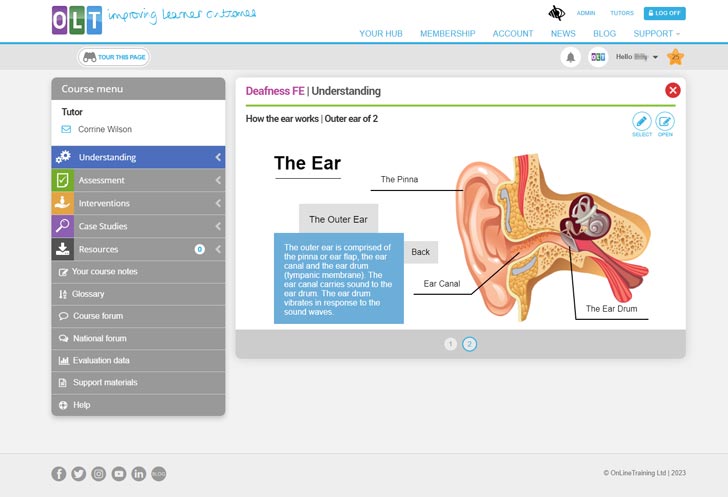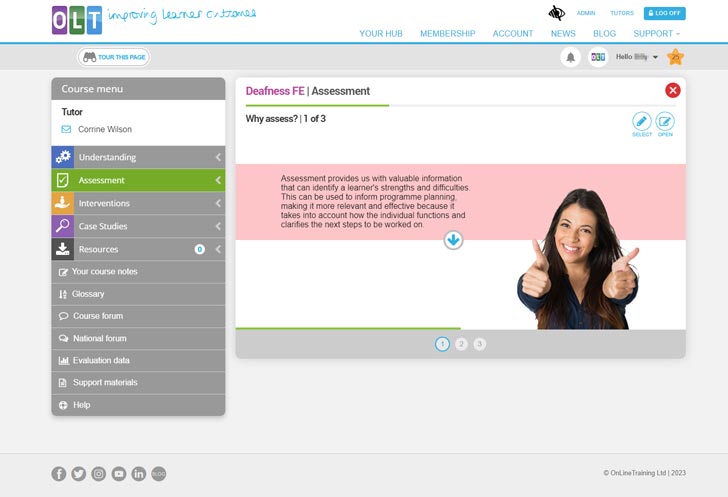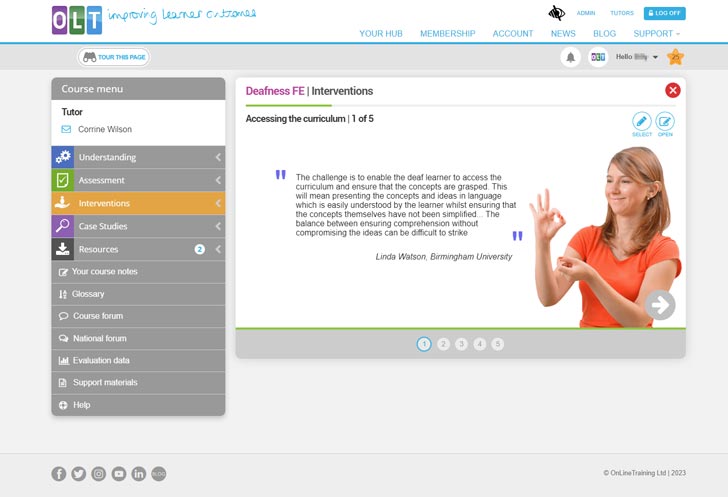Courses Paid courses Deafness (Hearing Impairment) FE
Deafness (Hearing Impairment) FE
| Achieve a certificate |

It is estimated that there are 53,954 children who are deaf in the UK and at least 70% will go on to further education (CRIDE, 2019). Despite further education being the most common post-school destination, pupils with deafness are twice as likely as their peers to drop out and fewer than 4% will achieve their AS level course qualification after completing the course (University of Manchester, 2011). Going to college can be a challenging experience for most pupils, as they adjust to independence and being more responsible for their academic achievement. This course aims to show how to make your practice more inclusive for these learners and offers practical assessment ideas and intervention strategies to help them feel part of the learning community and keep their learning on track.
This course responds to the information needs of the whole community centred around supporting the young person with a hearing impairment. You will learn how to assess the needs of a learner and go on to develop a support plan consisting of SMART goals and interventions, which you will implement and later review to determine how well it has met the learner’s developmental needs.
Our Hearing Impairment (FE) course is perfect for those who work with students in a further education setting such as teachers, college tutors, teaching assistants, heads of department and college leaders. This course is also useful for the parents/carers of students with a hearing impairment.
Course learning outcomes
On successful completion of the course, you will be able to:
- define the different causes of hearing loss and describe the impact on learning and social inclusion
- explain the range of communication modes used by students with a hearing loss
- identify different amplification devices, including additional listening devices, and describe how environmental adaptions can enhance hearing
- use checklists to carry out observations of a student’s functional hearing
- communicate clearly and effectively with deaf students
- implement strategies to support access to the curriculum, social inclusion and increase independence
- contribute towards planning interventions taking account of a student’s individual development profile and needs
- plan successful transition programmes to higher education or work
- create a support plan for a student/group of students in your school
Our courses are structured into four sections. Click on the section headings to reveal page titles and some example content.
Learn how the ear works, how to identify the different types of hearing loss, the role of hearing aids and the importance of inclusion in a further education setting.
- Course aims and objectives
- What do we mean by hearing impairment?
- Quiz: Hearing impairment - Facts and fictions
-
How the ear works

Screenshot from Understanding page 4 - Causes of hearing loss
- How do we measure hearing loss?
- Experiential activity: Missing letters
- Communication modes
- Hearing aids
- David talks about hearing aids
- Hearing aids: conductive and bone anchored
- Cochlear implants: Helen
- Cochlear implants: Jake
- Cochlear implants: Justine
- Impact of hearing loss
- Inclusion of learners with hearing impairment
- What do we need to make inclusion happen?
- Early diagnosis
- HI and additional learning needs
- Multi-sensory impairment
- End of section quiz
- Section summary
Explore some of the assessment tools used to monitor the progress of hearing-impaired students.
- Section objectives and your learner profile
-
Why assess?

Screenshot from Assessment page 2 - General awareness of hearing difficulties
- Assessing communication
- Problems with receptive language
- The hearing-impaired learner
- Functional assessment in the classroom
- Functional assessment in the classroom environment
- Functional assessment in the classroom environment 2
- Functional assessment in the classroom environment 3
- Social inclusion
- Course assignment: Your learner’s three SMART goals
- End of section quiz
- Section summary
Choose from a range of strategies to develop personalised programmes.
- Section objectives
-
Rules for good communication

Screenshot from Interventions page 2 - Using audio-visual materials
- Introduction to accessing the curriculum
- Different support options in an FE setting
- Transition planning for young people
- Advice on hearing equipment
- Developing good listening skills
- Learning independence
- Course assignment: Your learner’s interventions
- End of section quiz
- Section summary
View real life examples that illustrate the needs of the individual, the interventions implemented and their resulting progress.
- Case study: Charlotte – Sixth Form
- Case study: Sussex Downs College
- Case study: National Deaf Children’s Society Vloggers
I have been able to use a lot of information on dealing with my deaf student and his abilities, arranged for time out and quiet time, as I have understood the background noise issue and now appreciate how hard it can be. I have recommended this website to two friends who I used to work with, who are now in Primary schools and have put forward suggestions from this course, even something as simple as where to seat the learner. Thank you for extending the course for me, I am so pleased I was able to complete it.
Teaching Assistant (20/08/2021)
Really good to hear the voice of deaf learners in the HE / FE
Advisory Teacher (20/08/2021)
It has brought my knowledge/understanding up to date after time out of the workplace
Teaching Assistant (19/07/2021)
It is helpful to get a different perspective for college
Advisory Teacher (09/07/2021)
Before I did this course I only had a very basic knowledge of hearing impairment. I do not currently work with HI students but I maybe working with one next year so the information contained within this course will help me to support the student.
Teaching Assistant (01/07/2021)
I have a much clearer understanding of the different levels of hearing impairments and the aids that can be used. My understanding of how the environment can impact the learners experience has much improved too
Qualified Teacher (17/06/2021)
This has really raised my awareness of HI students' needs and how to work with the student to meet them. We've been able to implement a range of steps in our teaching centre to make the rooms better in terms of cutting background noise and being friendlier learning environments for deaf students. We've also managed to get clear guidelines for our local exams staff so that they know which special measures they are expected to provide to accommodate deaf students. This is a big step forward for them as when initially approached the did not know they were expected to make accommodations at all.
Qualified Teacher (14/02/2021)
| Rating |
| |
Delivery
|
| |
20 hours, 1-2 hrs per week |
| |
Flexible start date |
| |
Assignment
|
Licences
Your school or education system can purchase a licence to deliver our courses.
Contact us to find out moreCertification
20 hrs CPD Certified What's this?
Certificate of Achievement

